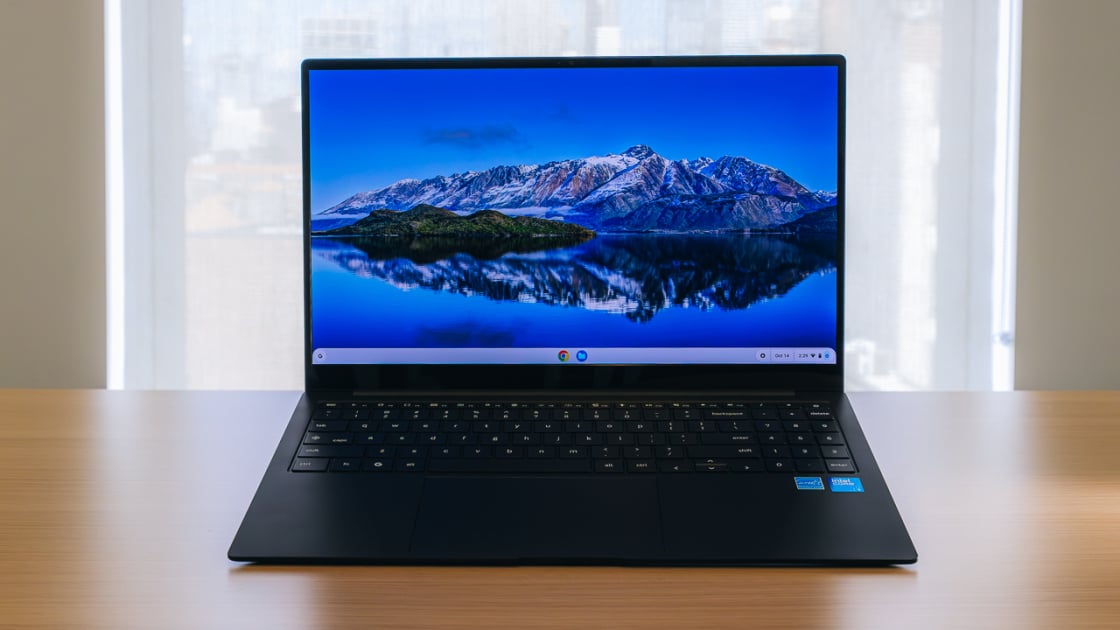
Check out our latest products
Budget laptops abound, but few can get you into a slick, capable machine for minimal cash better than a Chromebook. PCMag’s expert analysts have been testing and reviewing laptops for decades, including Chromebooks since their very inception. Using PC Labs’ detailed methodology, we test all Chromebooks for key aspects that include performance, battery life, and usability. Because Chromebooks aren’t compatible with most benchmark programs we use for Windows and macOS laptops (they run Google’s ChromeOS), we’ve adopted a unique slate to put these distinct laptops to the test. Our current recommendation for the best Chromebook overall is the Asus Chromebook Plus CX34 (2025) for its class-leading performance and features at an excellent price. Of course, we stand behind all of our best Chromebook picks, selected for specific usage scenarios and budgets. Explore them all below, plus a detailed buying guide and a selectable spec breakout.
Deeper Dive: Our Top Tested Picks
EDITORS’ NOTE
June 4, 2025: We added the Samsung Galaxy Chromebook Plus as our Best Big-Screen Chromebook, replacing the Acer Chromebook Plus 515. Since this article’s last update, we have tested and evaluated 27 new laptops (two of them Chromebooks) for possible inclusion in this roundup and across all of our laptop buying guides.

- Impressive CPU performance
- Pleasant keyboard and touchpad
- Lots of connectivity
- Attractive, friendly design
- A bit of flex to the chassis
- Basic 1080p display easily outclassed for not much more
- Enough battery for a workday—no more
Asus’ updated Chromebook Plus CX34 (2025) sticks to its roots as an incredible value. This Chromebook enjoys potent CPU performance with an upgraded Intel Core i5 processor and provides features comparable to midrange Windows laptops—all for less than 500 bucks. It also comes in a comfortable design with plenty of connectivity. Top it all off with AI-enhanced tools, and you have an attractive Chromebook that has become our new favorite and ranked as the best for most people.
This is the laptop to grab if you’re a shopper looking for a reliable Chromebook in the $400-to-$500 price range. Focusing on portability and ease of use, the Asus Chromebook Plus CX34 (2025) is suitable for everyday tasks—browsing, streaming, and productivity—without blowing your budget.
Class
Chromebook
Processor
Intel Core i5-1335U
RAM (as Tested)
8 GB
Boot Drive Type
UFS (Universal Flash Storage)
Boot Drive Capacity (as Tested)
128 GB
Screen Size
14 inches
Native Display Resolution
1920 by 1080
Panel Technology
IPS
Variable Refresh Support
None
Screen Refresh Rate
60 Hz
Graphics Processor
Intel Iris Xe Graphics
Wireless Networking
Bluetooth 5.3, Wi-Fi 6E
Dimensions (HWD)
0.74 by 12.9 by 8.4 inches
Weight
3.17 lbs
Operating System
Chrome OS
Tested Battery Life (Hours:Minutes)
10:51
Learn More

- Ultra-affordable
- Excellent battery life
- Chromebook Plus features enhanced with AI
- Sturdy design with plenty of ports
- Capable touch display
- Small storage capacity in most models
- Underwhelming performance
- Keyboard isn’t backlit
Our top budget Chromebook is the Acer Chromebook Plus 514. This 14-inch laptop is compact and lightweight, with excellent battery life to support its portable design and an above-average port selection. It features a 1080p touch screen and a processor that’s just enough for the internet-based ChromeOS. This model has the advantage of being part of Google’s Chromebook Plus line, which means access to useful AI-centric features to enhance your workflow while still coming in at a bargain price.
For a slick, portable Chromebook that’s easy on the wallet, the Chromebook Plus 514 is the number one choice. Whether you’re using it to take notes in class or meetings, stream media on the couch, or just enjoy the online tools and apps ChromeOS includes, the 514 is a fine value.
Class
Chromebook
Processor
Intel Core i3-N305
RAM (as Tested)
8 GB
Boot Drive Type
SSD
Boot Drive Capacity (as Tested)
512 GB
Screen Size
14 inches
Native Display Resolution
1,920 by 1,080
Panel Technology
IPS
Variable Refresh Support
None
Screen Refresh Rate
60 Hz
Graphics Processor
Intel UHD Graphics
Wireless Networking
Wi-Fi 6E, Bluetooth 5.1
Dimensions (HWD)
0.81 by 12.87 by 8.86 inches
Weight
3.15 lbs
Operating System
Google ChromeOS
Tested Battery Life (Hours:Minutes)
14:18
Learn More

- New AI features supercharge ChromeOS
- 12 months free Google One with Gemini Advanced
- Versatile, durable 2-in-1 design
- Intel Core Ultra processing and on-device AI
- Excellent battery life
- Clear, colorful touch screen
- Pen not included
- ChromeOS still has quirks
The Acer Chromebook Spin Plus 714 is essentially the perfect high-end Chromebook, making good on its higher-than-most price. This Chromebook’s 2-in-1 design meets any like-priced Windows machine for style, with an attractive all-metal chassis and a sharp 14-inch touch screen that looks excellent in both laptop and tablet modes. Now, the computer is driven by an Intel Core Ultra processor, paired with 8GB of memory and a 256GB solid-state drive. Connectivity includes Thunderbolt 4, HDMI-out, and Wi-Fi 6E. All of this helps make the Spin Plus 714 our first five-star Chromebook.
If you want to experience ChromeOS in its most performant and flexible form, look to the Chromebook Spin Plus 714 as your first choice. It combines dual-mode versatility and high-end build quality. With punchy performance, lengthy battery life, and lots of connectivity, this Chromebook provides a helpful balance of value and features in a high-style, sturdy package.
Class
Chromebook, Convertible 2-in-1
Processor
Intel Core Ultra 5 115U
RAM (as Tested)
8 GB
Boot Drive Type
SSD
Boot Drive Capacity (as Tested)
256 GB
Screen Size
14 inches
Native Display Resolution
1920 by 1200
Panel Technology
IPS
Variable Refresh Support
None
Screen Refresh Rate
60 Hz
Graphics Processor
Intel Graphics
Wireless Networking
Wi-Fi 6E, Bluetooth 5.2
Dimensions (HWD)
0.71 by 12.4 by 8.8 inches
Weight
3.21 lbs
Operating System
Chrome OS
Tested Battery Life (Hours:Minutes)
14:46
Learn More

- Sturdy 2-in-1 design mixes durability, flexibility
- Above-average ChromeOS performance
- Crisp display with touch and pen support
- Backlit keyboard
- Decent variety of ports
- Budget-feeling plastic construction
- Merely average battery life
- Stylus pen not included
The Chromebook Plus line has delivered when it comes to affordable Chromebooks that don’t skimp on capability, and the Lenovo Flex 5i Chromebook Plus stands out as our favorite lower-cost 2-in-1 in Google’s Chromebook Plus program. With flexibility for laptop and tablet use, along with excellent keyboard and pen support, it’s one of the best-value 2-in-1s around. For under $500, you get a reliable Chromebook experience, a crisp 1080p display, a healthy selection of ports, and even access to a bevy of apps and games in tablet mode.
Whether you’re a student, a professional, or a home user, the Lenovo Flex 5i Chromebook Plus is a capable Chromebook with a versatile 2-in-1 design, all in a budget-friendly package. That all makes the Lenovo Flex 5i Chromebook Plus our favorite budget 2-in-1 Chromebook.
Class
Chromebook, Convertible 2-in-1, Budget
Processor
Intel Core i3-1315U
RAM (as Tested)
8 GB
Boot Drive Type
SSD
Boot Drive Capacity (as Tested)
128 GB
Screen Size
14 inches
Native Display Resolution
1920 by 1200
Panel Technology
IPS
Variable Refresh Support
None
Screen Refresh Rate
60 Hz
Graphics Processor
Intel UHD Graphics
Wireless Networking
Wi-Fi 6E, Bluetooth
Dimensions (HWD)
0.72 by 9 by 12.4 inches
Weight
3.52 lbs
Operating System
Chrome OS
Tested Battery Life (Hours:Minutes)
11:43
Learn More

- Superb OLED display in an under-$500 detachable
- High-quality front and rear cameras
- Comes with keyboard cover and kickstand
- Ho-hum compute performance
- No audio jack, or 4G or 5G LTE option
- Stylus supported, but costs extra
Like with 2-in-1 Windows machines, most 2-in-1 Chromebooks are convertibles whose keyboards flip and fold under their displays. Lenovo’s IdeaPad Duet 5 Chromebook, in less common contrast, is a detachable model that jettisons its keyboard to become a genuine tablet—a stunning one with an ultra-colorful, ultra-high-contrast 13.3-inch OLED touch screen. Considering that the Duet 5 costs less than $500, its display puts even some of Microsoft’s ritzier Surface tablets to shame. This at least helps with the fact that its Qualcomm Snapdragon CPU isn’t the fastest, and that Lenovo charges an extra $33 for a stylus. (Plus, unlike Microsoft, Lenovo includes the keyboard cover in the box with the tablet portion.)
With impressively sharp 5-megapixel front and 8-megapixel rear cameras, the IdeaPad Duet 5 is a nifty 1.5-pound tablet that turns into a handy 2.2-pound laptop when you attach its keyboard cover and kickstand. (The keyboard cover isn’t a match for a real laptop keyboard, but they never are, and its typing feel is comfortable enough, for what it is.) This is a fine bargain alternative to a Surface Go 3 or an Apple iPad Air for students and families.
Class
Chromebook, Detachable 2-in-1
Processor
Qualcomm Snapdragon 7c Gen 2
RAM (as Tested)
8 GB
Boot Drive Type
eMMC Flash Memory
Boot Drive Capacity (as Tested)
128 GB
Screen Size
13.3 inches
Native Display Resolution
1920 by 1080
Panel Technology
OLED
Variable Refresh Support
None
Screen Refresh Rate
60 Hz
Graphics Processor
Qualcomm Adreno GPU
Wireless Networking
802.11ax (Wi-Fi 6), Bluetooth
Dimensions (HWD)
0.28 by 12 by 7.4 inches
Weight
2.24 lbs
Operating System
Chrome OS
Tested Battery Life (Hours:Minutes)
21:10
Learn More

- Among the least expensive convertible laptops on the market
- Sharp touch screen
- Tablet portion has a high-quality build for its price
- Headphone jack is back
- Test model includes stylus pen
- All models include bundled keyboard
- Middling performance and battery life
- Keyboard has squishy keys, is designed for smaller hands
If you want a low-cost ChromeOS tablet/laptop, the Lenovo Chromebook Duet Gen 9 is a compelling budget buy, supporting both Chromebook laptop functionality and Android apps in a tablet form factor. It’s priced at less than $400, but you might not guess it from the sturdy metal chassis and high-quality build. Lenovo’s versatile design pairs an 11-inch tablet with a keyboard cover and kickstand, and the company even includes a stylus, making it ideal for note-taking and drawing. Put it all together, and it’s an easy choice as our favorite budget 2-in-1 detachable Chromebook.
Anyone who values portability and a versatile 2-in-1 design should appreciate the Duet Gen 9, whether a student or a casual user at home. If you need more convenience and reliability than performance and premium features, this is the smartest ChromeOS tablet choice. It’s especially suited to younger users, given the compact overall size and the relatively tight keyboard layout.
Class
Chromebook, Detachable 2-in-1
Processor
MediaTek Kompanio 838
RAM (as Tested)
8 GB
Boot Drive Type
eMMC Flash Memory
Boot Drive Capacity (as Tested)
128 GB
Screen Size
10.95 inches
Native Display Resolution
1920 by 1200
Panel Technology
IPS
Variable Refresh Support
None
Screen Refresh Rate
60 Hz
Graphics Processor
ARM Mali-G57 MC3
Wireless Networking
802.11ax (Wi-Fi 6), Bluetooth
Dimensions (HWD)
0.30 by 10.1 by 6.6 inches
Weight
1.12 lbs
Operating System
Google ChromeOS
Tested Battery Life (Hours:Minutes)
6:01
Learn More

- Super slim and light
- Stunning AMOLED screen
- Snappy performance and class-leading battery life
- Useful port selection
- Productive keyboard with Quick Insert, Function keys
- Expensive
- No webcam privacy shutter
- No touch screen
- Lackluster speakers and webcam
Compact Chromebooks might be the norm, but a 15-incher sure is hard to beat on screen space. Of the 15-inch Chromebooks we’ve tested, we like the Samsung Galaxy Chromebook Plus best. With beefed-up specs and AI features as part of Google’s Chromebook Plus program, Samsung’s model has a capable Intel Core i3 processor that speeds through the less-demanding ChromeOS interface and 8GB of memory. Of course, the large AMOLED screen is a stunning touch that helps the laptop live up to its premium price.
The Samsung Galaxy Chromebook Plus is ideal for ChromeOS fans who want more screen real estate. Students will particularly appreciate this premium Chromebook’s high-quality display, uncompromising performance, and excellent design.
Class
Chromebook
Processor
Intel Core 3 100U
RAM (as Tested)
8 GB
Boot Drive Type
UFS (Universal Flash Storage)
Boot Drive Capacity (as Tested)
256 GB
Screen Size
15.6 inches
Native Display Resolution
1920 by 1080
Panel Technology
OLED
Variable Refresh Support
None
Screen Refresh Rate
60 Hz
Graphics Processor
Intel Graphics
Wireless Networking
802.11ax, Bluetooth 5.2
Dimensions (HWD)
0.46 by 13.99 by 8.89 inches
Weight
2.58 lbs
Operating System
Chrome OS
Tested Battery Life (Hours:Minutes)
16:20
Learn More

- Boosted productivity and gaming performance
- High-res IPS screen with 120Hz refresh rate
- Four-zone RGB keyboard with anti-ghosting
- Wi-Fi 6E and Ethernet
- Below-average battery life
- Non-touch display limits Android app use
If gaming online through services like Nvidia’s GeForce Now is what you’re after, stop searching with the Acer Chromebook Plus 516 GE (2025), the latest version of Acer’s superb gaming edition Chromebook. Thanks to an updated CPU, this Chromebook drives leading performance compared with most others. A slick 120Hz-refresh-rate IPS display and a customizable four-zone RGB keyboard (with anti-ghosting, to sort out your frenetic key-jamming in games) round out this Chromebook’s enhanced gaming experience. Connectivity powered by Wi-Fi 6E and Ethernet is excellent for work and play. As a Chromebook Plus model, it features AI enhancements that stand head and shoulders above older Chromebooks. Even better, it’s just $649.
Whether you’re a gamer without the budget for a big GPU or just a Chromebook user with gaming on your mind, the 2025 Acer Chromebook Plus 516 GE fills a special niche for both and does it at a budget-friendly price. This laptop is an excellent cheat code for getting into cloud gaming on the cheap.
Class
Chromebook, Gaming
Processor
Intel Core i5-120U
RAM (as Tested)
8 GB
Boot Drive Type
SSD
Boot Drive Capacity (as Tested)
256 GB
Screen Size
16 inches
Native Display Resolution
2560 by 1600
Panel Technology
IPS
Variable Refresh Support
Yes
Screen Refresh Rate
120 Hz
Graphics Processor
Intel Graphics
Wireless Networking
Wi-Fi 6E, Bluetooth 5.2
Dimensions (HWD)
0.84 by 14.0 by 9.8 inches
Weight
3.75 lbs
Operating System
Chrome OS
Tested Battery Life (Hours:Minutes)
9:16
Learn More
Get Our Best Stories!

All the Latest Tech, Tested by Our Experts
By clicking Sign Me Up, you confirm you are 16+ and agree to our Terms of Use and Privacy Policy.
Thanks for signing up!
Your subscription has been confirmed. Keep an eye on your inbox!
The Best Chromebooks for 2025
Compare Specs
Buying Guide: The Best Chromebooks for 2025
Most Chromebooks lack the powerful hardware of gaming laptops or mobile workstations, but most don’t need it. Because you’ll be visiting websites and running apps within ChromeOS, which is a souped-up version of the Chrome browser, the technical barrier to entry is low. This also frees you from downloading and installing traditional software; if you can’t do something from a standard webpage, chances are you’ll be able to from one of the thousands of apps and extensions available to ChromeOS users.
With just a few clicks, your Chromebook can have almost as much functionality as a budget Windows laptop, and most recent Chromebooks also let you install any app designed for the Android mobile OS. (Older or deeply discounted Chromebooks may lack Android support; you can check this list for the model you’re considering.) This means both the browser-based and Android versions of Microsoft Office are available if you want an alternative to Google Docs, Sheets, and Slides.
Additional Accessories You May Also Be Interested In…

(Credit: Joseph Maldonado)
One primary benefit of running web-based software is security. Chromebooks are immune to most of the viruses and other malware that often plague Windows systems.
ChromeOS updates also take just minutes to complete, rather than the several minutes or an hour you may have to wait for macOS and Windows to do their update thing. Although easy access to an always-on internet connection is a must for Chromebooks, you can perform most standard tasks offline and sync up later, so you needn’t stop working if there’s a Wi-Fi connectivity glitch.

(Credit: Joseph Maldonado)
IT management is also easier on ChromeOS. Schools have long taken advantage of Chromebooks’ easy-to-use fleet management tools, but business users got a huge boost when Intel launched vPro Enterprise for Chrome. Intel-powered Chromebooks can now enjoy the same security and management tools featured on other business laptops without the hassle of Windows. If ChromeOS has been looking like a good fit for your business, it just got even better.
With the best Chromebooks, you also don’t need to worry about long-term lasting power. Google has just increased the supported life of all Chromebooks from eight years to 10 years, meaning that you have a full decade of use knowing that you’ll continue getting automatic updates.
What Are Good Specs for a Chromebook?
When shopping for the best Chromebook for your needs, you’ll note less hardware variety than with Windows machines. These are the most important specs and factors to be aware of. Also note that a new class of Chromebooks, the Chromebook Plus family, is here. These machines mandate certain minimum Chromebook specs to guarantee a reliable user experience, including high-resolution cameras, IPS screens, and an 8GB floor for memory.

(Credit: Kyle Cobian)
The Chromebook Plus program has also been an introductory platform for Google’s Gemini AI in various ways. With its respective AI engine, almost everything a Windows laptop or MacBook can do, so can the latest Chromebook Plus laptops. Many of these features are handled via cloud servers, but some are executed on-device using the latest neural processors, particularly from Intel, in the highest-end Chromebook Plus laptops.
Screen Resolution
The usual native display resolution on a Chromebook will be 1,920 by 1,080 pixels, otherwise known as full HD or 1080p, but cheaper Chromebooks may still have lower resolution while deluxe models will go sharper. For most midsize Chromebooks with screens from 13 to 15 inches, 1080p is just fine. Entry-level models’ resolution of 1,366 by 768 pixels can look coarse and is only really suited for laptops with screens smaller than 12 inches diagonally. Try to avoid this resolution on any 13-inch or larger screen, or at least try to eyeball the display in person before you buy. Note that all Chromebook Plus models will have at least a 1080p screen.
Processor
If you browse with only a tab or two open, a low-end CPU like an Intel Core (no Ultra), Intel N-series, or MediaTek chip will suffice. Chromebooks based on Intel Core i-series or Core Ultra processors will allow for more multitasking, though they’ll also be more expensive. Note that AMD has C-series Ryzen mobile processors designed especially for Chromebooks, but they’re less common.
For $300, a Windows laptop with an Intel Core or N-series processor and 4GB of memory would be unpleasantly sluggish for everyday use, but a Chromebook with the same specs should be fine for basic tasks. If you tend to be a multitasker, though, consider a Core i-series or Core Ultra chip and 8GB of memory. Chromebook Plus models, which start at $399 and go up from there, will have at least an Intel Core i3 chip by default and at least 8GB. You may also see AI-centric Intel Core Ultra chips on the latest higher-end models.
Storage
Most of your files on a Chromebook will be stored in the cloud, so many Chromebooks include only a small serving (32GB or 64GB) of eMMC flash-memory storage on which to save your local creations. Look for an SD or microSD card slot if you think you’ll want to save more documents and files on the device. A growing number of the best Chromebooks, spec-wise, have 128GB or larger solid-state drives (SSDs), which are much faster as well as roomier than eMMC flash. Some very new models alternately employ UFS drives, something of a speed and price midpoint between eMMC and SSD. Chromebook Plus models will include at least 128GB of storage by definition.
Connectivity
Most Chromebook connections are wireless, as you’ll use the machine almost exclusively when attached to Wi-Fi. Wired Ethernet ports are rare, but support for 802.11ac Wi-Fi is ubiquitous, with 802.11ax Wi-Fi 6 found in most of today’s Chromebooks.

(Credit: Joseph Maldonado)
If you’ll need to give presentations from your Chromebook, an HDMI monitor port is usually more convenient than carrying a USB-C DisplayPort adapter. Also, look for a USB port or two if you want to attach a mouse, a flash drive, or another peripheral.
Gaming
Entertainment isn’t a big concern for classroom users, but gaming on Chromebooks is finally a reality. Not only do you have several ways to play on Chromebooks of all kinds, but the latest game-ready models are built to take advantage of cloud services like Nvidia GeForce Now and Microsoft’s Xbox cloud gaming.

(Credit: Joseph Maldonado)
The purpose-built gaming Chromebook is still very much a niche concept, but the combination of features and processing power makes these few models some of the best Chromebooks around. And even if you don’t buy a gaming-focused Chromebook, you can still have plenty of fun with a standard Chromebook, so check out the best Chromebooks for gaming for our latest reviews.
Are Touch-Screen and Tablet Chromebooks Worth It?
Today’s Chromebooks have stepped up from basic, bare-bones laptops to elegant computers with surprisingly rich capabilities. A few sport carbon-fiber chassis or lightweight magnesium alloy frames. Others not only swap out flash storage for a speedy SSD but feature a bright 1080p (or even higher-resolution) in-plane switching (IPS) display with sharp text, vivid colors, and wide viewing angles. Top models have premium styling that rivals any high-end Windows notebook.

(Credit: Joseph Maldonado)
That includes touch screens (ChromeOS is optimized for touch input), which are especially handy when you’re tapping away at Android apps designed for touch. And while most Chromebooks are traditional clamshell laptops, a growing number are 2-in-1 convertibles whose screens flip and fold into laptop, tablet, and kiosk or presentation modes, just like Lenovo’s Yoga and HP’s x360 systems. A handful of our best Chromebook picks are detachable, with kickstands and removable keyboards, comparable to Windows tablets. These days, a budget Windows laptop and a similarly priced Chromebook can look far more alike than you might expect.
Ready to Buy the Right Chromebook for You?
Whether you’re a Facebook or Instagram addict or you just need a machine for checking email and working in Google apps, Chromebooks are easy to use, convenient to take on the go, and relatively inexpensive. The loads of information and recommendations within this article should guide you well. If you’re on a tight budget but need Windows, our guides to the best cheap laptops and the best laptops for college students are worth a look, too. For more general buying advice, check out our comprehensive guide to today’s top laptop picks, regardless of price.

![[2025 Upgraded] Retractable Car Charger, SUPERONE 69W Car Phone Charger with Cables Fast Charging, Gifts for Men Women Car Accessories for iPhone 16 15 14 13 12, Samsung, Black](https://i1.wp.com/m.media-amazon.com/images/I/61SaegZpsSL._AC_SL1500_.jpg?w=300&resize=300,300&ssl=1)




![[True Military-Grade] Car Phone Holder【2024 Stronger Suction & Clip】 Universal Cell Phone Holder for Car Mount for Dashboard Windshield Air Vent Long Arm Cell Phone Car Mount Thick Case,Black](https://i2.wp.com/m.media-amazon.com/images/I/715PBCuJezL._AC_SL1500_.jpg?w=300&resize=300,300&ssl=1)
![[エレコム] スマホショルダー ショルダーストラップ 肩掛け ストラップホールシート付属 丸紐 8mm P-STSDH2R08](https://i3.wp.com/m.media-amazon.com/images/I/51BMFf06pxL._AC_SL1500_.jpg?w=300&resize=300,300&ssl=1)







